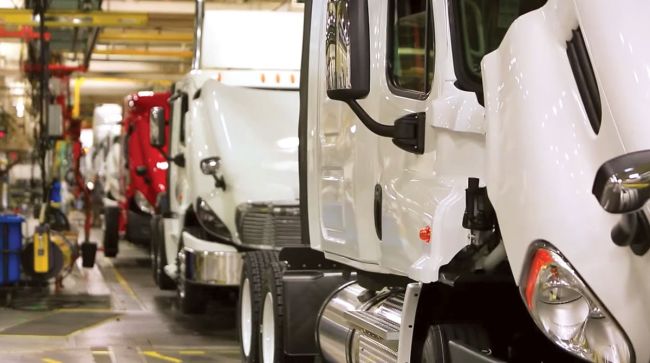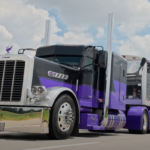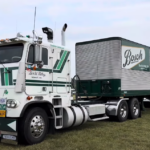In August, the demand for North American Class 8 trucks experienced a setback after three consecutive months of showing strong year-over-year growth, as reported by ACT Research.
According to the preliminary data from ACT, the number of orders for these trucks dropped by 12% in August, declining from 21,600 units in the same period last year to 19,000 units this year.
However, the report pointed out that despite this decline, August still marked the best month for Class 8 truck orders since February. It also highlighted that consistent economic strength and seasonal adjustments have helped maintain the overall order trend.
Moreover, there was a notable increase in orders compared to the previous month, with a significant 18.8% rise, as orders went up from 16,000 units in the prior month.
[August Preliminary State of the Industry: Classes 5-8 Vehicles Update] – August class 8 truck orders the best month since February at 19,000 units.
Get the update ➡️https://t.co/uQ0BEcVkSx#truck #semitruck #trucking #transportation, #Class8, #ACT, #ACTResearch pic.twitter.com/xAuRkgimmC
— ACT Research (@actresearch) September 5, 2023
“As represented by seasonal factors, the industry remains at that time of the year when expectations for order activity are low, as most of the current year’s orders have been booked and out-year build plans are only starting to open,” said Kenny Vieth, president and senior analyst at ACT. “For Class 8, August is the last month of ‘weak order season,’ the four-month period that begins in May. Adding to downward pressure, the 2023 build plan has been essentially filled since the end of Q1.”
FTR Transportation Intelligence released data indicating that there was a substantial 28% year-over-year decline in orders, with numbers dropping from 21,400 units to 15,400 units.
However, it’s worth noting that the comparison can be somewhat misleading because the results from the previous year were exceptionally robust. This time last year, there was a significant surge in order activity that extended all the way through November, marking the beginning of a sustained increase in orders.
“As build slots start to open for 2024 production, fleets are starting to place orders on the books,” said FTR Chairman Eric Starks. “However, much of the ordering for 2024 has yet to be seen and typically will not show up until September or October. Despite rising order activity, the year-over-year comparisons will look horrible through November due to record order activity in the second half of 2022.”
The FTR report also highlighted that order activity remains below the levels needed for replacement. Additionally, it revealed that over the past 12 months, orders for Class 8 trucks have amounted to 294,000 units.
“The actual unit order levels will be more significant in the near-term than the year-over-year change in analyzing the strength of the market,” Starks said. “Even though order activity is still below replacement demand, a key takeaway from the August data is that fleets are not shying away from ordering new equipment, which is a good sign for the second half of the year.”
The Environmental Protection Agency (EPA) has put forth what it has described as its most ambitious pollution standards to date, targeting cars and trucks. These standards, known as the Greenhouse Gas Emissions Standards for Heavy-Duty Vehicles — Phase 3, aim to establish rigorous criteria for reducing greenhouse gas emissions originating from heavy-duty vehicles, starting with the model year 2027. In addition to the EPA, the California Air Resources Board and various other state agencies have proposed their own regulations in this regard.
“It’s interesting times because next year, of course, we have the wave of greenhouse gas regulations coming into effect,” said Kyle Treadway, president of Kenworth Sales Co. “It’s new rules having to balance zero-emission vehicles and diesel vehicles. So the ordering process, we’re, as an industry, inventing it as we go. Yes, we’re used to allocation. We’ve been on allocation systems for the last few years, but it never gets any easier.”
Treadway pointed out that these regulations have added complexity for truck manufacturers when it comes to allocating resources. They now face the challenge of determining where to focus their efforts and investments, whether it’s on producing more electric trucks or continuing to manufacture diesel trucks.
“We have CARB regulations, which are on a different time frame than EPA regulations,” Treadway said. “And so, we have to be very cautious, as an industry, of where these vehicles end up being. To certify compliance, it now means we have to, as the delivery arm for the vehicle sale, prove that these vehicles are going into certain states and meeting whatever their requirement is, whether they’re a CARB state or not. So, it complicates the delivery process.”
Treadway has initiated the planning process for build slots and resource allocation for the initial half of the upcoming year. As of now, he hasn’t assigned specific slots to end consumers because there are still uncertainties regarding factors such as pricing and other variables for the following year. His goal is to gather as much information and address as many unknowns as possible so that when the time comes to accept customer orders, he can provide customers with comprehensive answers and solutions.
“We’re just in the throes right now of opening up the order boards and doing the allocation process,” Treadway said. “We don’t have end user names on specific slots yet. We don’t have pricing yet. We’re still just trying to wind things up so that when it is time to accept customer orders, we have answers to all their questions or as many of them as we can.”





